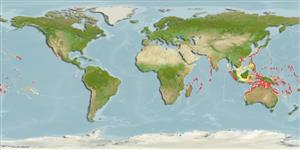Environment: milieu / climate zone / depth range / distribution range
Ecologia
marinhas associadas(os) a recifes; intervalo de profundidade 6 - 48 m (Ref. 9360). Tropical
Indo-Pacific: Comoro Is. and Chagos Archipelago east to Tonga, north to Ryukyu Is., south to Australia.
Tamanho / Peso / Idade
Maturity: Lm ? range ? - ? cm
Max length : 2.5 cm TL macho/indeterminado; (Ref. 30874)
Descrição suscinta
Chaves de identificação | Morfologia | Morfometria
Espinhos dorsais (total) : 6 - 7; Raios dorsais (total) : 8; Espinhos anais: 1; Raios anais : 7 - 8. Characterized by yellowish pink head; bluish grey to translucent pale yellowish body with dark brown scale margins forming network; red iris; all pectoral rays unbranched; branched fifth pelvic ray; longitudinal scale series 24-25; median predorsal scales 7-8; cheek or opercle without scales; depth of body 4.6 in SL (Ref. 90102).
Occurs in outer reef slopes (Ref. 90102). Minimum depth reported taken from Ref. 30874.
Ciclo de vida ou comportamento de acasalamento
Maturities | Reprodução | Spawnings | Egg(s) | Fecundities | Larvas
Randall, J.E. and M. Goren, 1993. A review of the gobioid fishes of the Maldives. Ichthyol. Bull. J.L.B. Smith Inst. Ichthyol. (58):1-37, 5 pls. (Ref. 9360)
Status na Lista Vermelha da UICN (Ref. 130435)
Ameaça para os humanos
Harmless
Uso pelos humanos
Ferramentas
Relatórios especiais
Baixar XML
Fontes da internet
Estimates based on models
Preferred temperature (Ref.
123201): 24.5 - 28.8, mean 27.4 °C (based on 420 cells).
Índice de diversidade filogenética (Ref.
82804): PD
50 = 0.5000 [Uniqueness, from 0.5 = low to 2.0 = high].
Bayesian length-weight: a=0.01023 (0.00477 - 0.02194), b=3.02 (2.84 - 3.20), in cm total length, based on LWR estimates for this (Sub)family-body shape (Ref.
93245).
Resiliência (Ref.
120179): Elevada, tempo mínimo de duplicação da população menor que 15 meses (Preliminary K or Fecundity.).
Fishing Vulnerability (Ref.
59153): Low vulnerability (10 of 100).
Nutrients (Ref.
124155): Calcium = 380 [164, 1,297] mg/100g; Iron = 1.9 [0.8, 4.2] mg/100g; Protein = 18 [16, 20] %; Omega3 = 0.174 [0.054, 0.546] g/100g; Selenium = 39.8 [11.7, 113.1] μg/100g; VitaminA = 92.7 [17.7, 466.0] μg/100g; Zinc = 4.62 [2.46, 7.73] mg/100g (wet weight);
